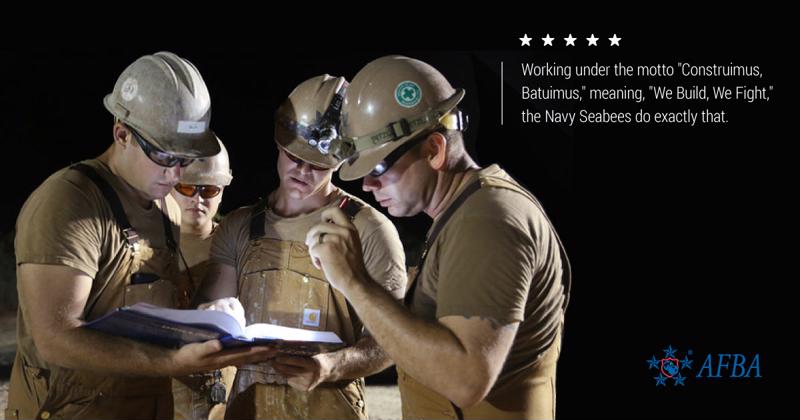On March 5, we commemorate the Navy Seabees by remembering their heritage and extensive contributions to Naval history.
Who are the Navy Seabees
Working under the motto "Construimus, Batuimus," meaning, "We Build, We Fight," the Navy Seabees do exactly that.
The Seabee designation refers to enlisted members and officers assigned to the U.S. Naval Construction Battalions, the Naval Construction Force (NCF) and enlisted members in the Navy's occupational field 7 (OF-7).
The unit's unusual name comes from the pronunciation of C.B. for "Construction Battalions." This has inspired the Seabee logo, which depicts a buzzing bee wielding construction tools.
Since WWII, Navy Seabees have been part of every major conflict the U.S. military has participated in. They have also dedicated their unmatched trade skills and military prowess to protect our nation and further humanitarian efforts, even in times of peace.

How the Seabees began
The Naval Construction Battalions were born out of a long tradition of utilizing Sailors' building skills to construct and maintain bases. But the Seabee unit was not formalized until the Second World War.
During WWII, the U.S. had contracted some 70,000 construction workers who were located at shore bases around the globe. But the use of civilian labor in international war zones was highly problematic. As civilians, these tradespeople had no legal protections and could not defend themselves against enemy attack. If they were to fight back, they would be classified as guerrillas and could be subject to battlefield execution, according to international law.
To address the need for skilled tradespeople with military might, Admiral Ben Moreell put forth an innovative proposal on Dec. 28, 1941. Moreell conceived of a new type of military unit that possessed the necessary construction trade skills and the flexibility to participate in a wide variety of large-scale projects.
On Jan. 5, 1942 the Bureau of Navigation granted Moreell the power to recruit construction workers for three newly created Naval Construction Battalions. U.S. Civil Engineer Corps officers were granted command authority over the enlisted members and officers of these units.
During recruiting, the emphasis was put on technical skills, so the earliest Seabee population skewed much older than the average Navy recruit. Experienced in more than 60 trades, some of the first Seabees had honed their craft working on highways, subways, quarries, dams, docks and skyscrapers. But they also received advanced military training, which came in handy during frequent interactions with the enemy.
The Seabee name was officially adopted on March 5, 1942 — hence the birthday commemoration on this date. By the end of WWII, roughly 325,000 enlisted members and nearly 8,000 officers called themselves Seabees. Together, they participated in building more than 400 bases which helped pave the way to an Allied victory. Initially considered part of the Navy Reserve, this militarized construction unit became a permanent part of the Navy in 1947, so that they could serve in peacetime as well as wartime.
Remembering Seabee contributions to Naval history
While most Seabees are part of Naval Construction Battalions or the NCF, the unit has and continues to serve in additional capacities.
Notably, during WWII, Seabees served on Naval Combat Demolition Units and were among the first ashore at Normandy on D-Day, being responsible for dismantling the German-built barriers designed to prevent amphibious landings. Other Seabees have worked tirelessly throughout the Korean War, Vietnam War, Desert Shield and Desert Storm.
Throughout their history, special units have been assigned to complex projects that call for advanced, highly specialized trade skills. Seabees have also made contributions to the U.S. Marine Corps and are consistently involved in public works projects, disaster recovery initiatives and humanitarian efforts.
On the March 5, we recognize and honor the men and women of the Navy Seabees.


